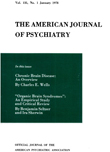Overview: public health issues in tardive dyskinesia
Abstract
Public health concern over tardive dyskinesia has been rising, but the magnitude of the problem has been undetermined. The incidence of tardive dyskinesia is unknown, and prevalence rates yield conflicting and possibly misleading estimates. The natural course of tardive dyskinesia is highly variable: in some patients (probably many fewer than previously believed) it is irreversible. No currently available therapeutic agent satisfies the criteria of safety, marked effectiveness, and prolonged efficacy in the treatment of tardive dyskinesia. Primary prevention involves reducing antipsychotic drug exposure, secondary prevention involves early diagnosis and prompt intervention, and tertiary prevention involves clinical measures to reduce disability and to treat severe cases vigorously. Educational methods that disseminate knowledge and influence prescribing habits need to be identified and used more widely.
Access content
To read the fulltext, please use one of the options below to sign in or purchase access.- Personal login
- Institutional Login
- Sign in via OpenAthens
- Register for access
-
Please login/register if you wish to pair your device and check access availability.
Not a subscriber?
PsychiatryOnline subscription options offer access to the DSM-5 library, books, journals, CME, and patient resources. This all-in-one virtual library provides psychiatrists and mental health professionals with key resources for diagnosis, treatment, research, and professional development.
Need more help? PsychiatryOnline Customer Service may be reached by emailing [email protected] or by calling 800-368-5777 (in the U.S.) or 703-907-7322 (outside the U.S.).



